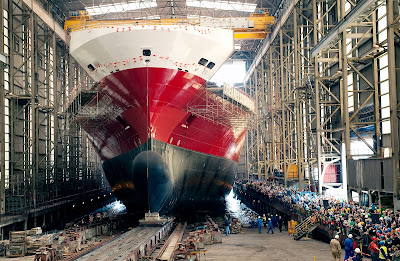The secondary sector of the economy is what most people call the industry. It is a key sector in most of the world economies and it led to important changes in society during the industrial revolution.
What is the secondary sector?
The secondary sector or secondary economic activity definition: includes economic activities that create finished products for consumption (consumer goods). It takes the production of the primary activities and manufactures new end goods.
Usually, secondary activities are divided into two sectors: light industry and heavy industry.

Light industries of the secondary sector
Light industry is mostly labor intensive and does not require large quantities of raw materials or large areas for production. It is also more geared towards producing for the end consumer than for other companies.
Examples of light industries of the secondary sector
- Food manufacturing such as dog and cat food manufacturing, flour and rice milling, and malt, breakfast cereal, chocolate and confectionery, frozen food, dried and dehydrated food, ice cream and frozen dessert manufacturing, etc.
- Beverage and tobacco product manufacturing such as soft drink and ice, bottled water manufacturing, wineries, breweries, and distilleries.
- Textiles mils, textile product mills, apparel manufacturing, leather, and allied product manufacturing.
Heavy industries of the secondary sector

Heavy Industry refers to the production of large-scale goods with a large-scale manufacturing process. In this type of industry, the use of capital is intensive. It employs a lot of raw materials, facilities, and areas for production.
Examples of heavy industries of the secondary sector
- Petroleum and Coal Products Manufacturing such as petroleum refineries, asphalt paving mixture, asphalt shingle, and coating materials manufacturing.
- Chemical manufacturing such as petrochemical, industrial gas, synthetic dye and pigment, and ethyl alcohol manufacturing. Also pesticide, fertilizer, and other agricultural chemical manufacturing.
- Glass and glass products.
- Cement and concrete production.
- Iron and steel mills and ferroalloy manufacturing, steel product manufacturing, alumina, and aluminum production and processing.
- Agriculture, construction, mining, and industrial machinery manufacturing.
- Transportation Equipment Manufacturing such as motor vehicle body and trailer manufacturing, aerospace product and parts manufacturing, and ship and boat Building.
Characteristics of the secondary sector of the economy
- World industry is concentrated in the United States, China, Europe, Japan, India, and South Korea.
- Light industries are located in urban areas, while heavy industries located mostly outside urban areas.
- Capital and labor intensive
- Depends on raw materials from the primary sector of the economy.




Leave a Reply